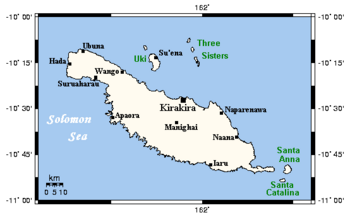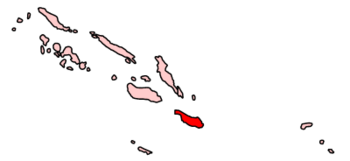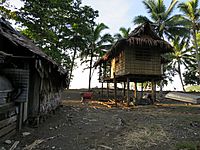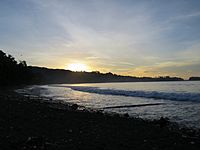Makira facts for kids

Makira and nearby islands
|
|

Location of Makira in Solomon Islands
|
|
| Geography | |
|---|---|
| Location | Solomon Islands |
| Coordinates | 10°33′04″S 161°49′41″E / 10.55111°S 161.82806°E |
| Area | 3,190 km2 (1,230 sq mi) |
| Highest elevation | 4,101 ft (1,250 m) |
| Highest point | Unnamed Point |
| Administration | |
|
Solomon Islands
|
|
| Province | Makira-Ulawa Province |
| Largest settlement | Kirakira |
| Demographics | |
| Population | 55,126 (2020) |
Makira is a large island in the Solomon Islands. It is also known as San Cristobal. Makira is the biggest island in the Makira-Ulawa Province.
It is the third most populated island in the Solomon Islands. About 55,126 people lived there in 2020. Makira is located east of Guadalcanal and south of Malaita. The main city and capital of the island is Kirakira.
Contents
Island History
The first Europeans to see Makira were part of a Spanish trip. This happened in June 1568. The trip was led by Álvaro de Mendaña de Neira.
A small boat from Guadalcanal first landed on Makira. This boat was called the Santiago. Hernando Enriquez was in charge of the boat. The island was then named San Cristóbal.
Learning and Education
The Stuyvenberg Rural Training Centre is an important school on Makira. It is a boarding school located on the north coast.
This center teaches useful skills for jobs. It is run by the Society of Mary.
Natural Environment
A large area of eastern Makira is very important for nature. This area covers about 182,550 hectares. Most of it is covered by forests.
BirdLife International has named this area an Important Bird Area (IBA). This means it is a special place for birds. Many threatened or endemic (found only there) bird species live here.
The area goes from the rocky coast up to the Bauro Highlands. It includes rivers like the Warihito and Raro. The land is rugged with steep valleys and many waterfalls. Most of the area is tropical rainforest.
Some things that could harm this environment are logging (cutting down trees), invasive species (plants or animals that don't belong there), and a growing human population.
Birds of Makira
Many special birds live on Makira. Some of these include:
- Melanesian scrubfowl
- Yellow-legged pigeons
- Crested cuckoo-doves
- Red-knobbed and chestnut-bellied imperial pigeons
- White-headed fruit doves
- Makira boobooks
- Pied goshawks
- Sanford's sea eagles
- San Cristobal dwarf kingfishers
- Meek's and duchess lorikeets
- Yellow-bibbed lories
- Green pygmy-parrots
- Makira honeyeaters
- Sooty myzomelas
- Long-tailed trillers
- Dusky fantails
- Makira flycatchers
- White-collared and Makira monarchs
- Island leaf-warblers
- Shade bush warblers
- Grey-throated white-eyes
- Makira starlings
- Makira thrushes
- Mottled flowerpeckers
Sadly, some birds have not been seen for a long time. The Makira woodhen has not been seen since 1953. The thick-billed ground dove has not been seen since 1927 and is thought to be extinct.
Other Animals and Plants
Besides birds, Makira is home to other unique living things.
- Five types of bats that are found only in certain areas live here.
- There might be a new type of giant rat (Solomys) on the island.
- Two types of Ficus (fig) trees are also found only on Makira.
Famous People
- Doreen Kuper was a special representative for New Zealand.
Gallery
See also
 In Spanish: Makira para niños
In Spanish: Makira para niños



